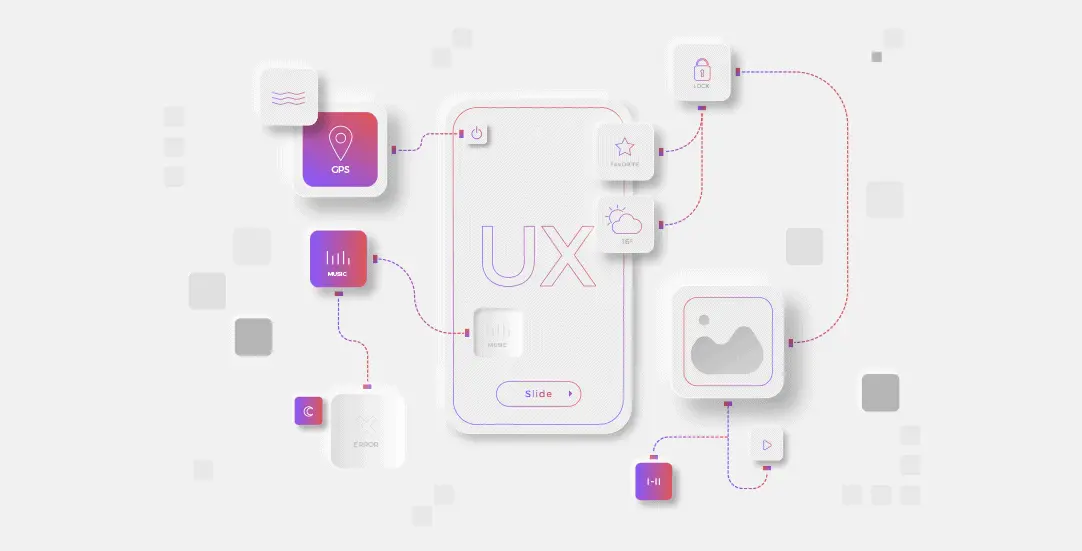UX design is trending

User experience design has become a frequent topic on the internet in recent years. The origins of the phrase can be traced back to late 1970s in some cases, but for example, for Apple computers, the term UX appeared when in 1993 Don Norman decided to give a name to his position at the company, thus becoming a User Experience Architect. Half a century later, the essence of system design, so the pillar of UX, remains the same. Everything begins and ends with a holistic experience provided by our product or service to the user.
Why bother with UX
How to stand out from other companies that offer similar products? How to gain the competitive edge? It’s not enough to be at the top of search engine results’ lists. Brand visibility on the internet is a critical factor, but it is equally important to properly design the way (the IT system/solution) we want to actually present the brand to potential customers. Nowadays, designers of IT systems develop more than just architecture and design. They work on the entire “usability”, and they construct “user experiences” from scratch. In other words, they forge the future success of the brand and its leading position on the market. Positive UX is one of the more important factors influencing the quality of a website and – possibly but not necessarily – the WOW factor of users.
What is UX design? – a user first approach
UX design definition can be quite simple. It is the design of experiences that accompany people when they use physical or digital products or services. The main goal of UX design is to increase the satisfaction from the use of products and services through proper functioning, intuitiveness, ease of use, and the supply of values important to the user. Quite often, UX is narrowed down to UI and an “esthetic website”, but it is worth remembering that the basis for building a product/service with high quality UX is to get to know the users first. Although User Experience generally refers to clients as the main users of the app/service, it is also an important factor for system administrators and business partners.
UX in numbers
To construct the best possible UX, aside from defining it, we also need to measure it. Getting to know your target group, the analysis of competition, strategy, products, clients, and the audit of current solutions – all of this has to be done with analytics tools. This will help better understand and later design a “positive customer experience”, in a slightly more measurable way than just through words such as “I like it” or “I don’t like it”. There are two types of studies UX is based on – qualitative and quantitative. Quantitative information answers the question how effective a given solution is. The data is used predominantly when the product is already present on the market so we can accumulate a significant number of results. The data may originate from such sources as the observed time spent on the website or the number of clicks on an advertising button compared to the number of visits. The information may also come from simple AB tests in which we release 2 mailing versions, first to a limited number of our subscribers and then, after the preliminary test, to our entire subscription base. Quantitative data can be used for a specific purpose, but it can also be accumulated all the time to control the results from the perspective of several months.
The second type is qualitative data, which shows the areas that require improvement, or the functionalities that users expect to have. This will enable us to test the architecture of information and learn how people use our products. Some useful methods include a detailed interview of a person from the target group, usability tests that assign specific tasks to our interviewee, or a heuristic analysis based on the work oriented around a checklist, experience and intuition.
UX – the art of compromise
The work on UX design means constant analysis and testing of the behavior of your audience. It often entails a compromise between the needs of the business, the expectations of users, the properties of the selected technology and the time for the implementation of the entire project. The bar in UX design is raised even higher due to the interdisciplinary character and wide scope of this term, which within the area of IT systems encompasses such elements as:
- User interface
- Design
- Content architecture
- Interactivity
- Functionality
- Usability
- Typography
- Content Marketing
- System management – the logic of data collection
Interestingly, UX combines two very polarizing approaches: the technical-functional aspect with the ideological-conceptual question about brand identity – “what is the purpose of all of this?”.
UX Design – the fewer the better
Why do we even need UX design with all these studies, analytics, testing and prototyping? We want our user to be able to do what he intends to do when visiting the website, and in the most comfortable way. We want him to have a smooth experience, to have a feeling he knows what he is doing, to have no problems with understanding the way the product operates. The solution has to work well for both new users with very limited or no experience, as well as for more advanced or professional audiences.
You don’t have to think about it all either. Simply allow us to design the perfect UX for you.


















